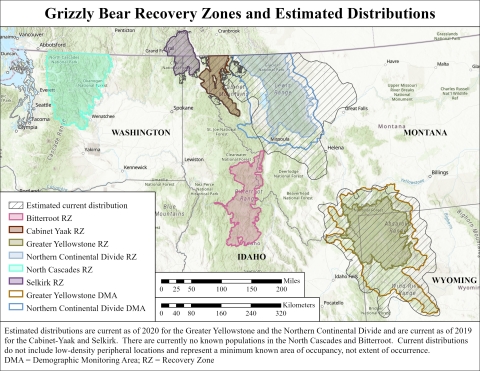Community engagement and collaboration
Questions and Answers: 90-day finding on grizzly bear petitions
February 3, 2023
Related: News Release - Service to initiate grizzly bear status review in the Northern Continental Divide and Greater Yellowstone ecosystems
---------------------------------------------------------------------
What is a 90-day finding? How does the petition process work?
- Petitions are formal requests to list or delist a species as endangered or threatened under the Endangered Species Act. The ESA requires the U.S. Fish and Wildlife Service to make an initial finding within 90 days as to whether the petition includes “substantial information” indicating that a listing or delisting may be warranted. If a substantial finding is made, the next step is to conduct a status review and issue a 12-month finding as to whether listing or delisting is warranted. Learn more about the petition process.
What is a “Distinct Population Segment”?
- The ESA allows the listing or delisting of a distinct population segment of vertebrates (i.e., mammals, birds, fish, reptiles, and amphibians). A DPS is discrete and significant to the species or subspecies to which it belongs. A DPS listing is described in geographic terms instead of biologically.
What did the Service conclude in their 90-day finding?
- The Service found that two petitions to delist grizzly bear populations in the GYE and NCDE provided substantial information indicating that the petitioned actions may be warranted. The Service will now conduct an in-depth status review to inform a 12-month finding as to whether the petitioned actions are warranted. The Service did not find that the petition to delist the entire grizzly bear in the lower 48 provided substantial information that the action may be warranted; no further action will be taken on this petition.
What geographic areas are impacted?
- The two petitions with substantial findings address grizzly bears in the Northern Continental Divide and Greater Yellowstone Ecosystems.
What are the next steps?
- The Service will now use the best available science to conduct a status review of the grizzly bear in the NCDE and GYE. This will include an assessment of recently enacted regulatory mechanisms in Montana and Idaho. The Service will then issue a 12-month finding as to whether the designation of respective DPS’ and delisting are warranted. The public can play an important role by providing relevant scientific and commercial information to be considered in the status review through regulations.gov.
How would grizzly restoration in the North Cascades affect the decision on whether to delist grizzly bears in other portions of the lower 48?
- The recently announced EIS process evaluating options for restoring grizzly bears to the North Cascades is separate from our pending decisions on petitions we received to delist grizzly bears in other parts of the species' range. This potential reintroduction project reflects the U.S. Fish and Wildlife Service's continued commitment to recovering grizzly bears in the lower 48 states. Establishing a population of bears in the North Cascades recovery area would contribute positively toward the status of the species, which in turn would be factored into future assessments of the status of grizzly bears in the lower 48 States.




